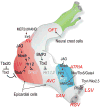Electrophysiological challenges of cell-based myocardial repair
- PMID: 20008740
- PMCID: PMC3293934
- DOI: 10.1161/CIRCULATIONAHA.107.751412
Electrophysiological challenges of cell-based myocardial repair
Figures




References
-
- National Institutes of Health, National Heart, Lung, and Blood Institute. Fact Book Fiscal Year 2005. Bethesda, Md: National Institutes of Health; 2006.
-
- Dimmeler S, Burchfield J, Zeiher AM. Cell-based therapy of myocardial infarction. Arterioscler Thromb Vasc Biol. 2008;28:208–16. - PubMed
-
- Murry CE, Reinecke H, Pabon LM. Regeneration gaps: observations on stem cells and cardiac repair. J Am Coll Cardiol. 2006;47:1777–85. - PubMed
-
- Boyle AJ, Schulman SP, Hare JM, Oettgen P. Is stem cell therapy ready for patients? Stem Cell Therapy for Cardiac Repair. Ready for the Next Step. Circulation. 2006;114:339–52. - PubMed
-
- Oettgen P, Boyle AJ, Schulman SP, Hare JM. Cardiac Stem Cell Therapy. Need for Optimization of Efficacy and Safety Monitoring. Circulation. 2006;114:353–8. - PubMed
Publication types
MeSH terms
Grants and funding
LinkOut - more resources
Full Text Sources
Other Literature Sources
Medical

